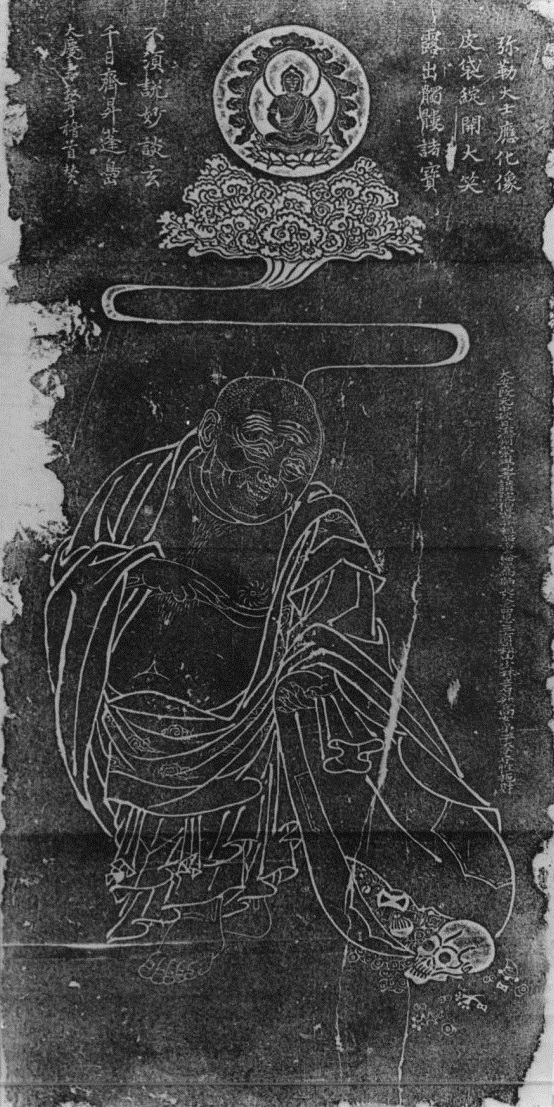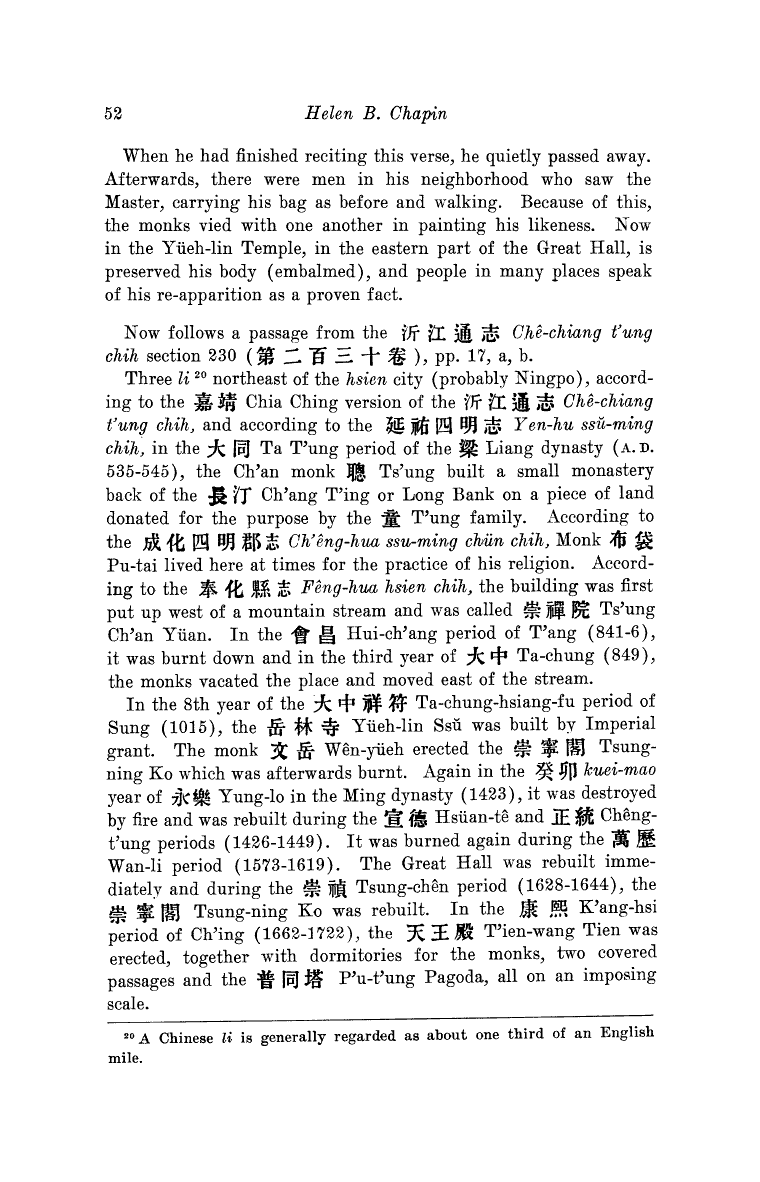ZEN IRODALOM ZEN LITERATURE
« Zen főoldal
« vissza a Terebess Online nyitólapjára

布袋 Budai (?-916) [Pu-tai]
布袋和尚 Budai heshang / 契此 Qici
(Rōmaji:) Hotei oshō / Keishi
(English:) Cloth-Sack monk / Qici, his Buddhist name, literally "Promise this"
(Magyar:) Pu-taj ho-sang / Vászonzsák szerzetes / Csi-ce
Tartalom |
Contents |
Pu-taj élete és mondásai |
Traditions that revere Budai GIF: Biography of Monk Pu-tai Ven. Mingzhou Fenghua Xian Budai (Hotei) |
Traditions that revere Budai / Conflation with other religious figures
1. As a Chinese Chan Buddhist monk
Budai heshang 布袋和尚 (his nickname: Cloth-Sack monk)
Qici 契此 (his Buddhist name: literal meaning "Promise this"
One belief surrounding the figure of Budai in popular folklore is that if a person is to rub his belly, it brings forth wealth, good luck, and prosperity. This belief however does not form part of any Buddhist doctrine. He is often admired for his happiness, plenitude, and supposedly wisdom of contentment.
Biography of Monk Pu-tai From the Jingde chuandeng lu 景德傳燈錄
Translated by Helen B. Chapin
Pu-taj élete és mondásai
Részletek a Csuan-teng lu [A lámpás hagyományozása / A lámpa-láng átadása] c. gyűjteményből
Terebess Gábor fordítása
Liang-kaj két festménye Pu-tajról
梁楷 Liang Kai (c . 1140 - c . 1210)
2. As an incarnation of Bodhisattva Maitreya
Milefo 彌勒佛 Bodhisattva Maitreya (the future Buddha)
is also attributed to a Buddhist hymn ( 偈语 jieyu) he uttered before his death:
彌勒真彌勒,化身千百億,時時示時人,時人自不識Maitreya, the true Maitreya
has billions of incarnations.
Often he is shown to people at the time;
other times they do not recognize him.*
Mi-lo, true Mi-lo
Reborn innumerable times
From time to time manifested to men
The men of the age do not recognize you*
Another translation by Lucien Stryk:
Maitreya! Maitreya!
Forever dividing himself,
He's here, there, everywhere—
Yet scarcely noticed.Maitréja földi megtestesülésének tartották
3. Laughing Buddha
Xiao Fo 笑佛 Laughing Buddha
Huanxi Fo 歡喜佛 Happy Buddha

A Nevető Buddha: Terebess szórólap
4. As Angida Arhat
Indian Names: Ingata or Angida Arhat (Yinjie-tuo 因揭陀 also written Yinjia-tuo 因迦陀)
Budai luohan 布袋羅漢 Cloth-Sack arhat
Buddha of infinite life,
Valuable bag containing
secrets of heaven and earth.
Happy and contented,
Cheerful and joyful is he.
According to legend, Angida was an Indian snake-catcher whose aim was to prevent the snakes from biting passers-by. After the snakes were caught, he would remove the venomous fangs and then release them in the mountains. It was due to this kindness of heart that Angida was able to attain enlightenment. He carried a bag to put the snakes in.
He is supposed to have appeared in Fenghua in Zhejiang Province in 907 A.D. as a mendicant monk carrying a bag. He was seen for the second time in China in 917 A.D., preaching on a rock next to the Yuelin Temple.
5. Oxherding Pictures
Pu-tai also is associated with the last panel of the Ten Ox-herding Pictures. These are ten images that represent stages of enlightenment in Ch'an (Zen) Buddhism. The last panel shows an enlightened master who enters towns and marketplaces to give to ordinary people the blessings of enlightenment.
6. Hotei 布袋 in Japanese popular culture included in the seven gods of good fortune (七福神 Shichi Fukujin, Seven Lucky Gods)
The seven deities have independent origins in Buddhism, Taoism and Shinto. Although the impetus for the grouping is uncertain, these seven auspicious deities are first believed to have been grouped together and given the name shichifuku during the Muromachi period . At first, the members of the group were not fixed and Benzaiten became one of the seven deities somewhat later. The group of seven may derive from the Chinese subject of Seven Sages in a Bamboo Grove chikurin shichiken 竹林七賢 of the Wei-jin period (Jp; Gi-Shin 魏晋: 220-420) or from the famous Buddhist term from the sutra NINNOUGYOU 仁王経, shichinan sokumetsu shichinan sokushou 七難即滅 七難即生, lit. seven adversities disappeared and seven fortunes arose). From the 15c. the shichifukujin gained in popularity, especially among urban merchants and artisans, as an auspicious omen and motif of good fortune and longevity, and appear in many painted, sculpted or printed examples. Hotei is a stout, pot-bellied figure who either leans on a huge, bag or carries it hung on the end of his staff which is slung over his shoulder.
7. Phra Sangkrachai (พระสังกระจาย)
In Thailand statues of Phra Sangkrachai can be found, not just in Chinese temples, but in also in most Thai Buddhist temples and as amulets as well .
![]()
![]()
![]()
Hakuin: Zazen
 |
Hakuin Hakuin おぼう 今日は "O bō! kyō wa "Hey, bonze! „Ej, bonc! |
![]()
Pu-taj élete és mondásai
Részletek a Csuan-teng lu [A lámpás hagyományozása / A lámpa-láng átadása] c. gyűjteményből
Terebess Gábor fordítása
„FENGHUA HSZIENBEN, Mingcsouban élt Pu-taj, akit Rongyos Zsák mesternek hívtak, mert olyanra hízott, mint egy jól kitömött batyu. A homloka szűk volt, a pocakja kövér, a beszéde szokatlan. Ott hevert le mindig, ahol rájött az alhatnék. Gyakran szundikált a hóban, csak úgy ültében, felhúzott térdekkel, de nem esett baja. A vállán átvetett boton lógott a batyuja, mindenét abban hordta magával. A vásártéren válogatás nélkül összekoldult bármit, amit csak meglátott, hogy megegye vagy eladja. Jövendőmondásban sosem tévedett. Eső előtt vízbe áztatott szalmabocskort viselt, száraz időben magaslábú sársarut. A környékbeli emberek figyelték a jövését-menését, és ebből tudták, milyen idő várható. 917-ben halt meg összefont lábakkal a Jüe-lin templom keleti tornácán ülve. Ám halála után is gyakran látták kószálni batyuval a hátán, és a szerzetesek versengtek egymással, melyikük tudja élethűbben megfesteni Pu-taj alakját.”
Ezt a két esetet jegyezték fel róla:
„Pu-taj egy szerzetes után eredt és a vállára tette a kezét. Mikor a szerzetes hátrafordult, a markát nyújtotta felé:
– Adj egy pénzt!
– Előbb hadd halljam az igazság szavát – mondta a szerzetes –, csak akkor adok.
A mester letette a batyuját és összekulcsolta a kezét.
– Mi a buddhizmus értelme? – kérdezte tőle egy Pao-fu nevű szerzetes.
Pu-taj letette a batyuját és összekulcsolta a kezét.
– Ez minden? – kérdezte tovább Pao-fu. – Nincs ennél fontosabb?
Pu-taj felvette a batyuját és otthagyta.”
Ezt a verset írta magáról:
„Árva csészémből ezer család rizsét eszem,
Tízezer mérföldön át magamban kószálok.
Botorok szavát készpénznek nem veszem,
Az igazságra fehér felhők közt találok.”
![]()
![]()
Liang-kaj két festménye Pu-tajról
梁楷 Liang Kai ( c . 1140 - c . 1210)
Liang-kaj |
 |
Liang-kaj |

Stone rubbing
of Pu-tai
The Ch'an Master Pu-tai
Helen B. Chapin
Journal of the American Oriental Society
Vol. 53, No. 1 (Mar., 1933), pp. 47-52






Ven. Mingzhou Fenghua Xian Budai (Hotei)
No. 27.10 in: Records of the Transmission of the Lamp: Volume 7: Biographies and Extended Discourses. (Books 27-28),
Translated by Randolph S. Whitfield, Kindle Edition, 2019
Concerning Budai (Cloth Bag ?-916 CE) of Fenguan Xian in Mingzhou (Zhejiang), there are no details of his place of birth or family name. Rather plump, with a wrinkled forehead and big belly, the words that came out were not coherent; he would lie down to sleep just where he happened to be, carried a cloth bag on the end of his staff, in which he hoarded all bits and pieces offered to him. When coming to a market place or a village to beg, whether he was given some pickled meat, fish or salted vegetables, all would go into his mouth, with a small portion cast into a cloth bag for later; people of the time called him Zhangting Zi (Big Bag Boy) or Budai Shi (Master Cloth Bag). Budai used to lie down [to sleep] in the snow without getting wet; people found this strange. Sometimes he would sell things from his sack and they would ask him to tell their fortunes, which invariably came true. When it was about to rain he would wear wet straw sandals and walk very quickly; if it was dry and sunny, high wooden clogs.* He would sit eyes closed on the market bridge with his knees high up against his chest.** The local people could tell [what the weather would be] by this.
*Wooden open footwear: 高齒木履 gaochi mulü (lit. ‘high teeth wooden shoes’), in Japanese Geta (下駄) – with a thong on top passing through the big and first toe and two ‘teeth’ under the board/sole that raise the footwear above the ground when travelling outside.
** In the Jiangnan region of the Yangze River, markets were often divided and connected by a bridge. Knees high up against his chest, 豎膝 shuxi.
One day a monk was walking in front of the master; the master tapped him on the back, the monk turned round and the master said, ‘A penny for me.’
‘Say something good, then you will get a penny,’ replied the monk.
The master put down his cloth bag and, palms together in reverence, just stood.
Ven. Bailu asked, ‘What is the cloth bag?’
The master then put down the cloth bag.
‘What is the cloth bag laid down?’ asked Bailu again.
The master just took up his burden and left.
Ven. Xian Baohu asked, ‘What is the main thrust of the Buddha-dharma?’
The master put down his cloth bag and placed his palms together in reverence.
‘Is it only this or is there something higher still?’
The master took up his burden and left.
The master was standing in a main thoroughfare when a monk asked him, ‘What is the venerable sir doing here?’
‘Awaiting someone,’ replied the master.
‘Arrived! Arrived!’ (Guizong Rou also said, ‘Returned gone back.’)
‘You are not the one,’ said the master.
‘Who is this man?’
‘Give me a penny,’ said the master.
The master had a song:
Just the heart of hearts, that heart is Buddha
The most numinous thing in the world’s ten directions
Everywhere its marvellous function brings real empathy
Of all things, nothing so good as heart’s authentic reality
So bound and caper free in that which is not
Leisurely, leisurely after all, is a homeless son
Gaze the eyes ahead, on the authentic great Dao
Not seeing fine details is also very strange
Ten thousand dharmas, what is special; heart, why different?
Why spend labour searching meaning in sutras?
Heart is originally self-ruled, separate from knowledge
Wise ones only realise there is no end to study
Neither mundane nor sacred – what then?
Not intentionally divisive, a sage’s bent is solitariness
Without prizing the jewel of the heart, original purity
All other marks are false, empty names
Man can promote the great Dao, then Dao bestows illumination
Measureless, pure, high, called inherent Dao
Taking the staff climbing the road in the ancient country
No worries if the news is nowhere heard
There was also a verse:
One alms bowl feeds a thousand families
A solitary self, roaming ten-thousand li
Men gazing with heaven-blue eyes are few
Ask for the road to the limit of the white clouds******
一鉢千家飯
孤身萬里遊
青目覩人少
問路白雲頭From one bowl, I eat the rice of a thousand families;
All alone, I wander ten thousand li.
Those who find favor in my eyes are few.
Among the white clouds, I search for Truth.Translated by Helen B. Chapin
In one bowl, rice from 1000 households;
all alone, I have wandered for 10,000 leagues.
These way-seeking eyes see few people;
to ask directions, I turn to the white clouds.Translated by T. Griffith Foulk
In the 2nd year of Zhenming of the Later Liang dynasty (916 CE), in the 3rd month, corresponding to the thirteenth year of the sexagenarian cycle, the master, about to reveal his cessation, sat on a large rock below the eastern gallery of Yuelin Temple and recited a poem:
Maitreya, True Maitreya
Dividing your body a million fold
All the time revealing it to time-bound men
Time-bound men, selves unaware
Poem finished, transformation followed peacefully. After this people came from other places to look upon the master; taking up the cloth bag, then off on the road again. Then the four assemblies contended for his portrait. Today the body, wholly intact, can be seen in the eastern hall of the main temple at Yueling Temple.